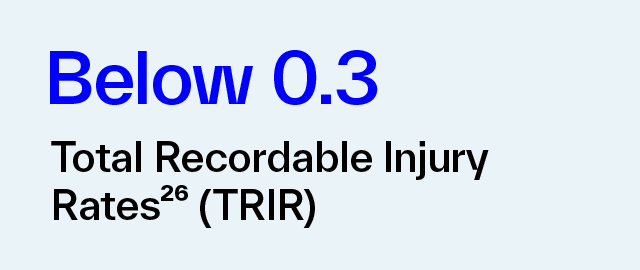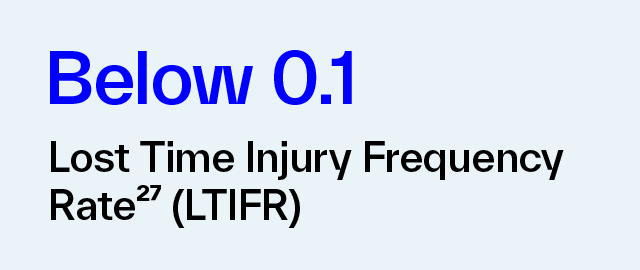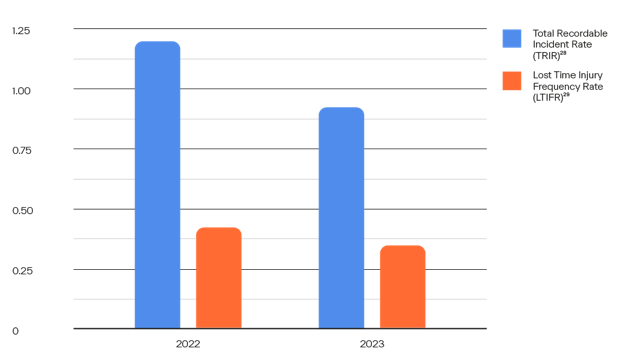Health & Safety

Our associates are our greatest asset and we want to ensure we are respecfful, nurturing and prioritizing safety. Health & Safety (H&S) has been identified as one of our three corporate values. Strong safety and health processes are essential to our business.
Our Environmental, Health & Safety (EHS) team oversees our H&S strategy by conducting audits of our operations, addressing remediation issues at our sites and assuring overall safety compliance. EHS efforts are divided between our two business units: Microbial Control Solutions (MCS) and Nutrition, Care and Environmental (NCE). Our MCS business unit has a shared EHS approach that is supported by our newly forged corporate EHS organization, transcending business unit boundaries to leverage best practices. To ensure that our H&S efforts are fully implemented at our individual facilities, the corporate EHS team, together with operations, is supported by dedicated personnel at the site level. These teams report to our group operations function and are primarily responsible for managing day-to-day H&S activities at our sites and facilities. By establishing clear lines of responsibility and oversight at both the corporate and business unit levels, we are effectively managing and promoting a H&S culture throughout our organization, positioning us to achieve our global H&S goals.
By 2030, we aim to achieve:


Safer together at Arxada
Our Safer Together at Arxada initiative reaffirms and further integrates the H&S culture at Arxada. Led by our corporate EHS team, Safer Together at Arxada focuses on our core values of Safety and Health, Ethical Behavior and Respect for People and Planet. The program aims to engage all associates to work collaboratively and foster new leadership behaviors in safety. It also acts as a key driver for our 2030 H&S goal. Safer Together at Arxada emphasizes the importance of bringing people together locally and globally, encouraging the collaboration and sharing of learnings and best practices.
We engaged a wide range of associates in the rollout of our program through various digital and in- person channels, including targeted webinars, workshops and discussions involving team members at all levels of the business. We hosted more than 20 seminars on safety leadership behaviors, which were attended by over 200 leaders, ranging from senior executives to front-line supervisors.
In November 2022, we conducted a survey that showed 79.8% of all our associates were familiar with the program and 68% were seeing a positive impact related to it. Additionally, our survey showed that 92% of all associates see themselves as committed to the new EHS Aspiration and Purpose statement that was developed and communicated by a global team as part of this roll out effort. We plan to conduct this survey again in Q3 of 2024.
In 2023, we implemented our new Life Saving Rules, a set of essential, non-negotiable safety protocols intended to prevent Serious Injury or Fatality (SIF) incidents by addressing relevant safety-related topics. Through these Life Saving Rules, we aim to improve worker safety, enhance operational efficiency and promote a strong safety culture within our company directly and positively.
Arxada life saving rules
As part of efforts to implement Safer Together across Arxada, we also revised and entirely reshaped our policies and procedures landscape to better give clear and hands-on guidance on how to achieve best- in-class safety results. This new landscape is now split into high-level standards, mandatory procedures and supporting step-by-step guidance documents fully aligned and built on our non-negotiable Life Saving Rules. This step ensures strong support for our purpose of using better science to solve the world's toughest preservation challenges.
Creating a Health & Safety culture
We want our associates to understand the importance of H&S and live our Safety and Health values in their everyday actions. To help embed H&S into all we do, our associates on all levels have an annual H&S performance goal tailored to their specific role that reflects their contribution to Arxada's overall H&S performance. All Arxada associates are required to complete H&S training, including all relevant standard operating procedures for the processes they perform. For example, office-based and sales associates may be required to receive training on topics such as our policy for using phones when driving, while those who work with chemicals receive training on safe handling. In addition, all associates must complete H&S refresher training on an annual basis and take part in regular emergency response drills specific to each location. By providing tailored training to our associates, we are ensuring that they are equipped with the knowledge and skills needed to work safely and effectively, no matter the role.
In 2023, we focused on increasing and measuring the H&S related engagements made available to our associates. Our goal was to make sure these engagements were valuable and relevant to their work. Throughout various trainings and initiatives, we have ramped up our individual associate safety engagements from 17,451 in 2022 to 74,593 in 2023.
To further prioritize safety throughout our company, in 2023 we launched comprehensive SIF prevention inspections. These inspections identify SIF precursors, such as high-risk activities or equipment malfunctions, and assist with implementing proactive injury mitigation measures. SIF prevention inspections are carried out by a team of trained associates who thoroughly observe and evaluate the conditions, equipment, procedures and associate practices. The team evaluates 18 key risk areas, including Lock Out/Tag Out, loss of primary containment and other safety controls, using a customized checklist. This year, 1,994 in-depth SIF prevention inspections were conducted throughout our operations, compared with 502 in 2022.
Management & auditing of sites
The corporate EHS team is responsible for regular audits of every Arxada facility to ensure that site-level EHS practices comply with regional laws and our own policies. Our audits allow us to better mitigate EHS-related risks and to ensure standardized H&S practices globally.
In addition to following regulatory auditing requirements, we follow a risk-based auditing system, grouping our sites into categories that determine the frequency of their auditing. At a minimum, every site is audited every three years.
During audits, we assess our sites based on their risk management systems and performance and their compliance with a range of EHS-related issues, including H&S measures, emergency preparedness and response, and the handling, storage and disposal of waste. We also conduct assessments for industrial hygiene and personal protective equipment. In 2023, we carried out nine audits and assessments across the 28 sites of our global audit program.
When Arxada acquires a new facility, we conduct a separate EHS gap assessment in addition to our regular auditing process. This assessment is designed to identify areas where current practices may need to be improved or established to meet our standards. After completing the assessment, our EHS teams work with the evaluated sites to discuss the findings and develop an action roadmap for the next 12 to 18 months to address any identified weaknesses. By proactively identifying and addressing potential EHS issues, we are ensuring that all our sites operate in a safe, compliant and sustainable manner.
One hundred percent of our operational sites have conducted associate H&S risk assessments, which evaluate potential workplace hazards and how to minimize the impacts. These assessments are routinely updated to reflect the latest regulations and industry standards and take into account any audit findings or other safety events including near misses.
Our Health & Safety Performance
In 2023, we improved our H&S performance, with our Total Recordable Incident Rate (TRIR) and Lost Time Injury frequency rate (LTIFR) decreasing by 0.34 and 0.03 respectively. Read more about our Safer Together at Arxada program and our efforts to identify root causes of H&S incidents to prevent reoccurrence below.

Events & incidents
While we are working hard to maintain a rigorous and comprehensive H&S culture, incidents can happen. When they do occur, we learn and adapt to prevent reoccurrences. We utilize two specific approaches:
1. Root cause analysis: Using the definitions of the Center for Chemical Process Safety for leading and lagging process safety metrics, we require a thorough and detailed root cause analysis for every registered Tier 1 and 2 incident.³⁰,³¹
Through root cause analysis, we can identify why an accident occurred and implement measures to prevent it from occurring again. This approach has been in place at our legacy sites for some time. We have been working to align this methodology across all our global operations, offering training in EMEA, APAC and the Americas. To broaden the reach and effectiveness, the analysis and cause mapping are shared with all EHS and site managers during a monthly global call. This allows us to implement our learnings on a global scale.
2. SIF program: As part of our Safer Together at Arxada program, we implemented a SIF program and integrated this into our corporate H&S processes. As part of this, SIF training was carried out at manufacturing sites globally, and we are committed to thoroughly investigating all registered incidents and examining their potential to cause acute injury or fatalities. By actively engaging our associates and managers in this process, we aim to identify and eliminate any potential sources of serious harm in our operations.
Looking forward to 2024
n 2024, we are setting our sights on further improving our process safety by bolstering our Process Hazard Analyses (PHA) and control measures for Loss of Primary Containment (LOPC). Our primary objective is to identify, assess and prioritize potential hazards, such as chemical, physical, or mechanical hazards, which could lead to accidents, incidents, or adverse consequences. By involving multidisciplinary teams to examine various aspects of PHA and LOPC, we can better understand the present hazards, mitigate risk and prevent potential incidents.
[26] [28] An injury or illness is considered a recordable incident if it results in any of the following: death, days away from work, restricted work or transfer to another job, medical treatment beyond first aid, or loss of consciousness. Additionally, a significant injury or illness diagnosed by a physician or other licensed healthcare professional is considered a recordable incident, even if it does not result in death, days away from work, restricted work or job transfer, medical treatment beyond first aid, or loss of consciousness.
[27] [29] Rates are calculated as the number of injuries in the reporting period x 200,000 / Total hours worked in the reporting period.
[30] Leading metrics are a forward-looking set of metrics that indicate the performance of the key work processes, operating discipline, or protection layers that help prevent potential incidents. Lagging metrics are a retrospective set of metrics based on incidents that meet an established threshold of severity.
[31] Tier 1 incidents are described as catastrophic and exceed a defined threshold level, whereas a Tier 2 incident is used to normalize the industry metrics and provide a minimum and upper limit threshold range.


